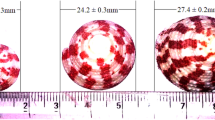Abstract
The preliminary purification and antimicrobial mechanism of antimicrobial peptide from Antarctic Krill were studied in this paper. The results showed that the molecular weight range of antimicrobial polypeptide (CMCC-1) obtained by cation exchange chromatography was between 245-709D as detected by molecular sieve chromatography, and the minimum inhibition concentration (MIC) of CMCC-1 against Staphylococcus aureus was 5.0 mg mL−1. The antimicrobial mechanism of CMCC-1 was studied with S. aureus as indicator bacterium. Compared with control group, the results of the experimental group in which S. aureus was treated with CMCC-1 were as follows: 1) CMCC-1 could inhibit cell division at logarithmic phase. 2) The protein and reducing sugar content, and the conductivity of culture medium increased, and the activity of alkaline phosphatase and β-galactosidase could be detected in the culture medium. 3) Observation under scanning electron microscope revealed that somatic morphology became irregular, and then somatic surface became coarse. The cell became much smaller, and most somatic cells gathered. The boundary between cells became dim and finally fused as a whole. 4) Observation under transmission electron microscope showed that the surface of S. aureus became rough and the reproducing ability was restrained. The cell wall became thin and the cytoplasm shrunk. Substances inside cell leaked out, which caused cells death. 5) SDS-PAGE analysis showed that some bands disappeared, and the residual bands became vague. 6) The genomic DNA electrophoresis results showed that the genomic DNA bands of S. aureus were not degraded but the brightness significantly reduced. Thus, it is supposed that CMCC-1 could destroy the cell wall and membrane of S. aureu, increase the cell membrane permeability and the leaking-out of intracellular substances, and thus cause the death of S. aureu.
Similar content being viewed by others
References
Alejandro, M. S. M., Abimael, D. R., Roberto, G. S. B., and Nobuhiro, F., 2011. Marine pharmacology in 2007-8: Marine compounds with antibacterial, anticoagulant, antifungal, anti-inflammatory, antimalarial, antiprotozoal, antituberculosis, and antiviral activities; affecting the immune and nervous system, and other miscellaneous mechanisms of action. Comparative Biochemistry and Physiology, Part C, 153: 191–222.
Gregory, M., Neumann, R. C., Gideon, M., and Polya, M., 1996. Purification and sequencing of yellow mustard seed napin small and large chains that are phosporylated by plant calcium-depended protein kinase and are calmodulin antagonist. Plant Science, 119: 49–66.
Gu, S. Q., Wang, X. C., and Lu, D. X., 2004. Study on the antibacterial mechanism of carp protamine. Journal of Yunnan University (Natural Sciences), 26(6): 100–104.
Hara, S., and Yamakawa, M., 1996. Production in Escherichia coli of Moricin, a novel type antibacterial peptide from the Silkworm, Bombyx mori. Biochemical and Biophysical Research Communications, 220: 664–669.
Hatanaka, A., Miyahara, H., Suzuki, K. I., and Sato, S., 2009. Isolation and identification of antihypertensive peptides from Antarctic Krill. Food Science, 74(4): 116–120.
Inigo, E., Jonathan, L. W., Douglas, G. B., and Kenneth, G. F., 1990. Implications of a new acoustic target strength for abundance estimates of Antarctic krill. Nature, 345: 338–340.
Lee, H. J., Choi, G. J., and Cho, K. Y., 1998. Correlation of lipid peroxidation in Botrytis cinerea caused by dicarboximide fungicides with their fungicidal activity. Journal of Agricultural Food Chemistry, 46: 737–741.
Liu, L., Liu, C. C., Zhao, Y., Wang, X. C., and Li, J. L., 2010. Recent advances in the healthcare function and food safety of Antarctic Krill. Food Science, 31(17): 443–447.
Lu, W., Ren, G. P., and Song, J. M., 2005. Determination of content of peptides in protein hydrolysates. Food Science, 26(1): 7169–7171.
Pan, Y. J., Hao, Y. J., Qu, H., Shan, Y., Li, D. S., and Du, R. Q., 2006. Preliminary studies on antibacterial mechanism and analysis of antibacterial activity of chitosans. Chinese Journal of Antibiotics, 31(6): 361–365.
Schnapp, D., Kemp, G. D., and Smith, V. J., 1996. Purification and characterization of a proline-rich antibacterial peptide, with sequence similarity to bactenecin-7, from the haemocytes of the shore crab. Carcinus maenas. European Journal of Biochemistry, 240: 532–539.
Shen, X., Sun, S., Wang, H. Q., Wang, M. X., Ren, J. F., Zhang G. T., and Liu, B., 2008. Mitochondrial genomic characteristics of Euphausia Superba and its application as molecular markers. Oceanologia et Limnologia Sinica, 39(5): 446–454.
Sun, S., and Yan, X. J., 2001. Active substances in the Antarctic Krill. Chinese Journal of Polar Research, 13(3): 213–216.
Sun, X., Wang, J. C., Li, H. T., Du, G. C., and Guo, D. S., 2005. A study on the antibacterial mechanism of rosmarinic acid. Journal of Qingdao University (Natural Science), 18(4): 41–45.
Wang, G. L., Jiang, D., and Fang, H. J., 2004a. Study on bacteriostatic action and mechanism of arisaema consanguineum schott. Chinese Journal of Animal and Veterinary Sciences, 35(3): 280–285.
Wang, G. L., Jiang, D., Fang, H. J., and Li, X., 2004b. Study on mutation breeding of high bacteriocin-producing strain WJK84-1 and antimicrobial mechanism against crown gall disease of plant. Acta Microbiologica Sinica, 44(1): 23–28.
Wang, G. L., Tang, J. H., Jiang, D., Fang, H. J., and Liu, Z. B., 2006. Bacteriostatic action and mechanism of Sophora flavescens ait on Escherichia coli 01 C84010. Scientia Agricultura Sinica, 39(5): 1018–1024.
Wu, W. P., and Xie, Y. L., 2010. Antarctic Krill and Krill fishery. Modern Fisheries Information, 25(1): 10–13.
Zhao, L., Cao, R., Liu, Q., and Wei, Y. X., 2011. Antimicrobial activity of polypeptides from Antarctic Krill. Progress in Fishery Sciences, 32: 112–116.
Zhou, X. H., Zhang, X. X., Zhu, X. L., Wei, W., and Zhu, Z. J., 2009. Preliminary study on antibacterial activity and mechanism of propolis. Food Science and Technology, 34(5): 233–236.
Author information
Authors and Affiliations
Corresponding author
Rights and permissions
About this article
Cite this article
Zhao, L., Yin, B., Liu, Q. et al. Purification of antimicrobial peptide from Antarctic Krill (Euphausia superba) and its function mechanism. J. Ocean Univ. China 12, 484–490 (2013). https://doi.org/10.1007/s11802-013-2180-2
Received:
Revised:
Accepted:
Published:
Issue Date:
DOI: https://doi.org/10.1007/s11802-013-2180-2




